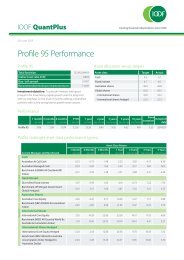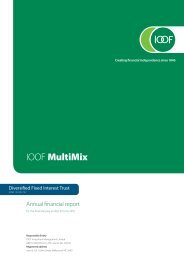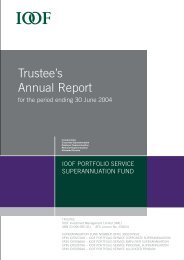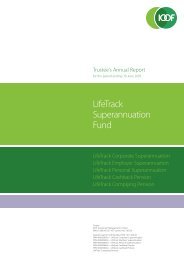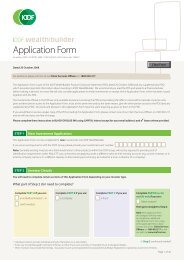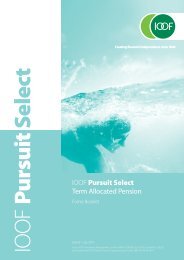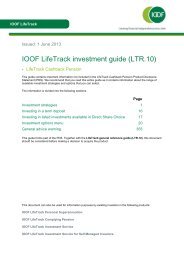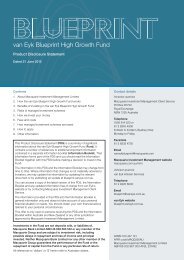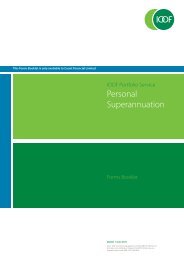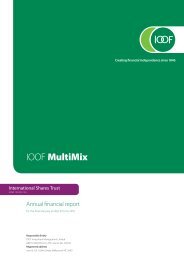annual report 2011
annual report 2011
annual report 2011
You also want an ePaper? Increase the reach of your titles
YUMPU automatically turns print PDFs into web optimized ePapers that Google loves.
IOOF | <strong>annual</strong> <strong>report</strong> <strong>2011</strong><br />
Notes to the financial statements (cont’d)<br />
For the year ended 30 June <strong>2011</strong><br />
with other receivables or payables in the Statement of<br />
Financial Position.<br />
Cash flows are presented in the statement of cash flows on a<br />
gross basis. The GST components of cash flows arising from<br />
investing or financing activities which are recoverable from,<br />
or payable to, the Australian Taxation Office are presented as<br />
operating cash flows.<br />
(q) Deferred acquisition costs<br />
Deferred acquisition costs relate to service fees paid, and are<br />
deferred as an asset in recognition that they relate to a future<br />
economic benefit. Deferred acquisition costs are initially<br />
measured at historical cost and are written down immediately<br />
to their recoverable amount if the carrying amount is greater<br />
than its estimated recoverable amount.<br />
Deferred acquisition costs are progressively amortised in profit<br />
or loss by a systematic allocation over the period of time the<br />
future economic benefits are expected to be received. The<br />
amortisation period is between 5 and 7 years.<br />
(r)<br />
(i)<br />
Investment contract liabilities and claims<br />
expense<br />
Investment contracts with Discretionary<br />
Participation Features (DPF)<br />
The value of these liabilities changes in relation to the change<br />
in unit prices for unit linked contracts, and are decreased by<br />
management fee charges. In accordance with the rules of the<br />
funds, any remaining surplus is attributed to the policyholders.<br />
Adjustments to the liabilities at each <strong>report</strong>ing date are<br />
recorded in profit or loss.<br />
(ii)<br />
Other investment contracts<br />
The value of these liabilities changes in relation to the change<br />
in unit prices for unit linked contracts, and are decreased by<br />
management fee charges. In accordance with the rules of the<br />
funds, any remaining surplus is attributed to the members of<br />
the fund. Amounts distributable to members are recorded in<br />
profit or loss as an expense.<br />
There is no claims expense in respect of life investment<br />
contracts. Surrenders and withdrawals which relate to life<br />
investment contracts are treated as a movement in life<br />
investment contract liabilities. Surrenders are recognised when<br />
the policyholder formally notifies of their intention to end the<br />
policy previously contracted.<br />
(s)<br />
Insurance contract liabilities and claims<br />
expense<br />
Life insurance contract liabilities are calculated in accordance<br />
with actuarial standards.<br />
A claim expense is recognised when the liability to the<br />
policyholder under the policy contract has been established,<br />
or upon notification of the insured event. Withdrawal<br />
components of life insurance contracts are not expenses and<br />
are treated as movements in life insurance contract liabilities.<br />
(t)<br />
Shareholders entitlement to monies held in<br />
statutory funds<br />
Monies held in the life insurance Statutory Funds (including<br />
the Benefit Funds) are subject to the distribution and transfer<br />
restrictions and other requirements of the Life Insurance Act<br />
1995. Monies held in the benefit funds and controlled trusts<br />
are held for the benefit of the members of those funds, and are<br />
subject to the constitution and rules of those funds.<br />
(u) Earnings per share<br />
The Group presents basic and diluted earnings per share data<br />
for its ordinary shares. Basic earnings per share is calculated by<br />
dividing the profit or loss attributable to ordinary shareholders<br />
of the Company by the weighted average number of ordinary<br />
shares outstanding during the year, adjusted for treasury shares<br />
held.<br />
Diluted earnings per share is determined by adjusting the<br />
profit or loss attributable to ordinary shareholders and the<br />
weighted average number of ordinary shares outstanding,<br />
adjusted for treasury shares held, for the effects of all dilutive<br />
potential ordinary shares, which comprise performance rights<br />
and share options granted to employees.<br />
(v) Segment <strong>report</strong>ing<br />
Determination and presentation of operating<br />
segments<br />
An operating segment is a component of the Group that<br />
engages in business activities from which it may earn revenues<br />
and incur expenses, including revenues and expenses<br />
that relate to transactions with any of the Group’s other<br />
components. All operating segments’ operating results are<br />
regularly reviewed by the Group’s Managing Director to make<br />
decisions about resources to be allocated to the segment<br />
and assess its performance, and for which discrete financial<br />
information is available.<br />
Segment results that are <strong>report</strong>ed to the Managing Director<br />
include items directly attributable to a segment as well as<br />
those that can be allocated on a reasonable basis. Unallocated<br />
page 64



